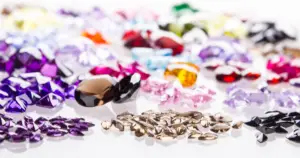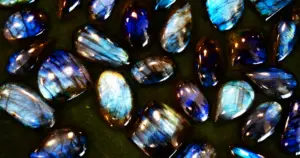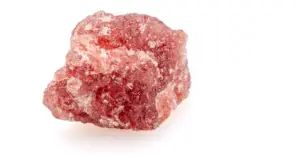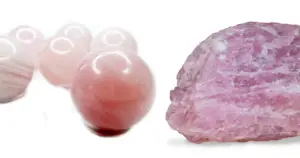How to Tell if Moonstone is Real or Fake in 6 Easy Ways
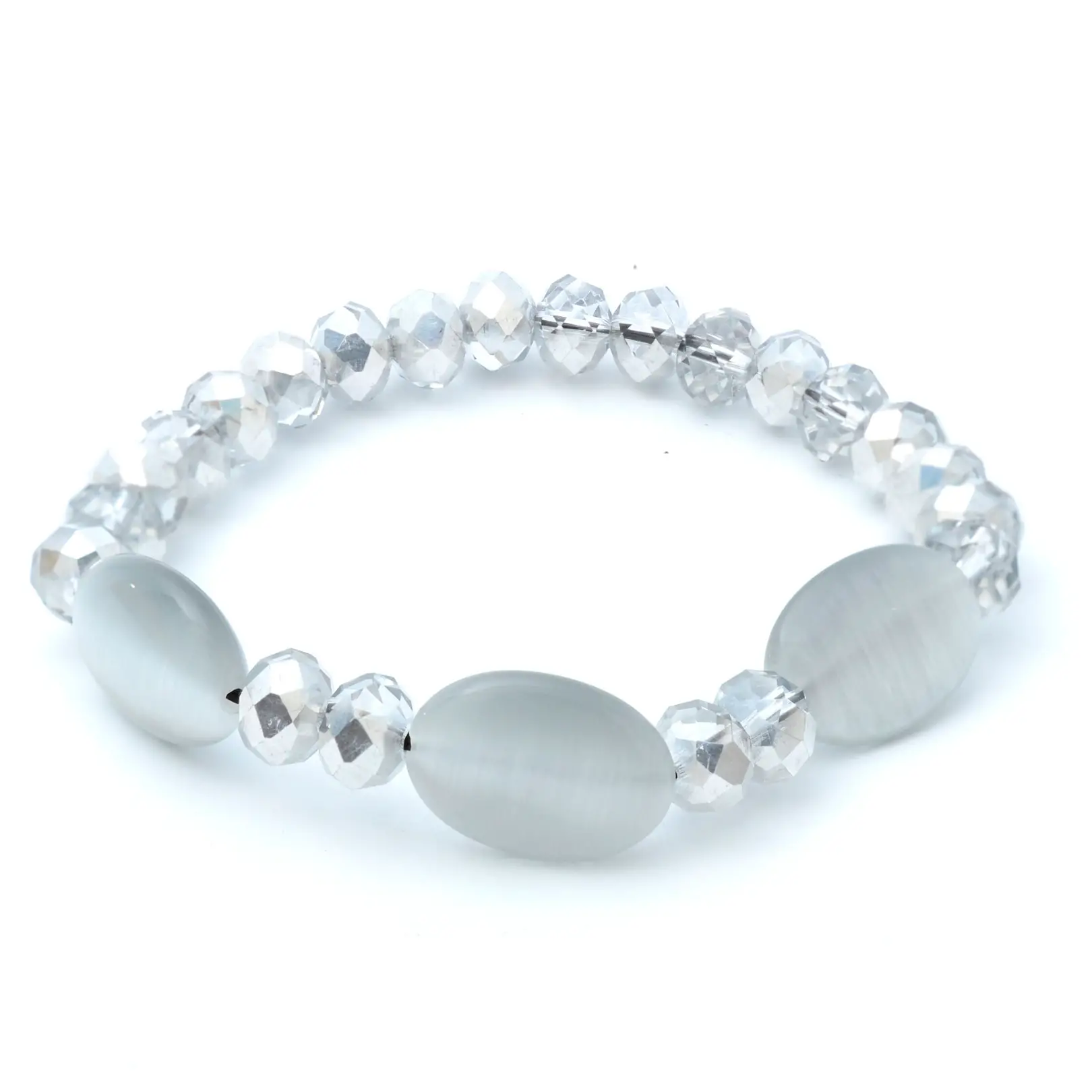
Moonstones belong to the feldspar group of minerals and are made of two minerals—orthoclase and albite, which are found stacked in layers within the stone. Read to know how to tell if Moonstone is Real or Fake.
Moonstones are relatively complex, colorless bi-axial crystals and are available as flawless single gemstones of fairly big size.
Here is a comprehensive guide to spotting the Real Moonstone from a Fake one in 6 Easy Ways.
Table of Contents
How are Moonstones faked?
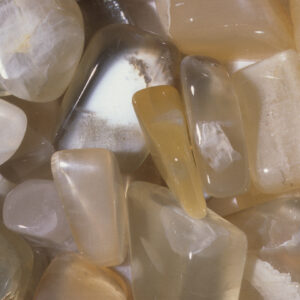
Moonstones are known for their remarkable optical property: a bluish-white sheen called opalescence, visible when light hits the specimen at particular angles. Writers on gems seem to have recognized that this is due to light reflection from a specific plane within the crystal.
These days, a typical fake doing the rounds in online crystal stores goes by the name of Opalite or Opalite Quartz. It is not a gemstone, not opal, Moonstone, or quartz, but a pretty glass called Opalite. Many sellers also refer to Opalite as “Sea Opal” or “Moonstone” or just “Opal” and lots of other extraordinarily misleading or downright false names for this glass stone.
Opalite is often carved into figures, such as talismans or Buddhas and skulls, etc., and lately, it has been cut or molded into crystal points and sold as beads or briolettes. If you want to know all about Moonstone benefits, read here.
If you are looking to buy Moonstones in the market today, here are a few physical features to keep in mind to identify fakes:
How to tell if Moonstone is Real or Fake?
Look for Adularescence
One of the oldest and best sources of Moonstone was Mount Adular in Switzerland, formerly known as St. Gotthard. From this name, the stone’s ancient name is derived, adularia. Although that name is rarely used today, gemologists around the world refer to Moonstone’s sheen as adularescence-it results from the interplay of light with layers of tiny albite crystals in these stones.
The thinner the coating, the bluer the glow; the thicker, the whiter. Strictly speaking, the term adularescence is just a synonym for the more widely known term “opalescence.” Moonstones exhibiting this sheen are singular crystals and differ in this respect from opals or iridescent shells.
- The sheen of natural moonstones occurs due to reflection from within the crystal. Frequently, Opalite can replicate this shine only on the surface, not at the level of internal composition.
- Hold out your stone under the sun and move it in your palm to check this. In a natural moonstone, you should be able to see a reflective light moving inside, not on top of it.
- The vigor and intensity of this peculiar reflection, which is highly colored, is due to regularly spaced repeated twinning inside the crystal.
- Opalite, a typical fake, often mimics this surface-level “glow” and is carefully photographed to enhance this glow, as in the picture of the Opalite necklace given above. Opalite appears milky-white translucent with golden highlights when viewed against a light background. If Opalite is placed against a dark background, it will have a blue glow.
Therefore, the “glow” of Opalite glass, unlike a Real Moonstone, changes when viewed against light or dark backgrounds.
Observe Coloration

When choosing Moonstones, European connoisseurs look for two things: ideal body and sheen color. You might ask What is the big deal with it? For body color, it’s complete colorless transparency. Plastic fakes can often be opaque. Despite their current milky appearance, Moonstones are considered of the highest quality when they are transparent.
For sheen, it’s a deep, haunting sky blue that glides across the dome or table of a stone as it is moved against the light.
Like most ideals, the one for Moonstone is rarely attained. What is known as “semi-blue” and “silver-white” stones are sometimes passed off as blue sheen, but they don’t rank as true-blue moonstones.
Ask for the Origin
Years ago, when a majority of the world’s highest grade blue-sheen moonstone supply came from Myanmar, there was no need to stretch this term so far out of bounds. But, based on reports from dealers who regularly travel to Thailand, where most new Burma gem production is smuggled to market, Burma-like Sri Lanka- can no longer be counted on for any more than an intermittent handful of blue beauties. Although America, Mexico, and Tanzania, among others, produce Moonstone, the output is sparse and far from ideal.
Look for Chatoyancy
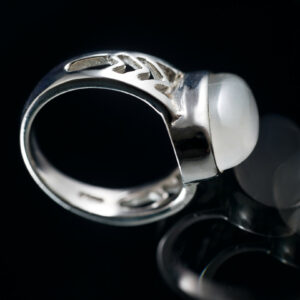
As discussed above, Moonstone’s crystallography is biaxial. This means that when a light beam passes through it, the light splits into two factions, both of which move in different directions at different speeds.
As a result, many highly cloudy moonstones, some with strong body color, are cut into high-domed cabochons so that their sheen collects in a chatoyant (resembling the optical phenomena of the eye of the cat) silver-white band across the top.
These stones are known as “cat’s-eye moonstones” and are readily available in 10 to 20-carat sizes. Occasionally, cat’s-eye moonstones have a second band, or ray, intersecting the first at a right angle. Some dealers call these stones with cross-shaped eyes “star moonstones.”
Suppose you are seeking stones more nearly reminiscent of conventional vibrant blue-sheen Moonstone. In that case, you may be interested in looking for a new·variety feldspar, properly called bytownite, coming out of India. These stones are commonly called “rainbow moonstones” because they feature a multicolored adularescence. The finest have a reddish-orange or sometimes a lavender sheen with areas of green and blue. Lesser grades have a more predominantly brownish sheen.
Observe Inclusions
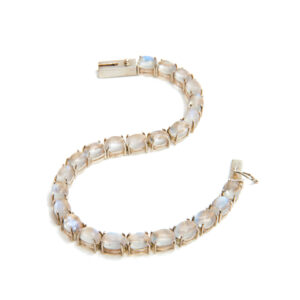
Real Moonstones are characterized by fissure systems in the body of the material created by air and heat pressures at the time of formation. By looking at a Real Moonstone, you can see several layers within the stone most of the time.
As a result, natural Moonstones have inclusions or cracks and other features within the stone and won’t be perfectly clear like glass or Opalite. Some extremely high-end Moonstone varieties look nearly transparent due to their transparency, but even these will not have that milky glass appearance like Opalite.
Fissure systems are visible to the naked eye as short parallel cracks. Real Moonstones also have dark rectangular areas due to stress cracking or negative crystals. Sometimes a cavity extends from such a dark rectangular area that creates an inclusion with a comma shape.
Burmese moonstones are known to be characterized by oriented needle inclusions.
Observe Stone Size
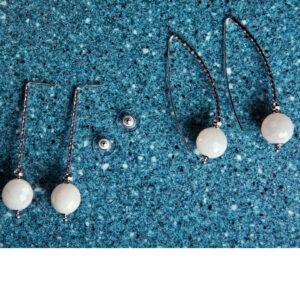
Moonstones are a historically valued, rare find in large and fine quality. This is entirely contrary to Moonstones of Indian origin, which have strong body colors, are abundant, and are very inexpensive.
Most Indian moonstones tend to be well-cut and very attractive. Moonstone with a blue sheen is the most valuable and is rare in stones over 15-20 carats. Those occurring with silvery or white adularescence are abundant in the market and available in sizes up to hundreds of carats.
Check for Temperature
Unlike fakes such as standard plastic and sundry Opalite varieties, a genuine Moonstone does not warm quickly to body temperature and remains cool even after sustained contact with the human body.
One way to check this when buying is to hold the stone close to your cheek. If it feels more relaxed than your skin and stays such even after a considerable amount of time in your palms, you can be assured that it is a naturally occurring gemstone.
Final Comments
In this article, we have offered you a guide to common Moonstone fakes and how to avoid them. Most of the distinguishing features of Moonstones are predominantly optical and reasonably easily identifiable.
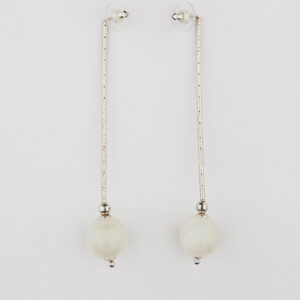
A birthstone for those born in June, Moonstone has usually been considered an alternative to a pearl, at least for most of American history. However, in Europe, where most birthstone lists put Moonstone ahead of pearl, it is often the other way around: Pearl is considered a substitute for Moonstone since the latter is much valued.
You can begin by looking at what you see: the shine on your stone, its response to light and dark light, and how it appears on the inside. Those new to this gem should remember that moonstones have a far-from-rugged hardness of 6-6.5 on the Mohs scale. Often they also have extremely strong cleavages, making them susceptible to breakage.
Therefore, they have to be kept with great care when wearing these gems, especially if they are mounted in rings. If you are a regular Moonstone user, comment below and tell us how introducing the stone into your daily life has affected it.
We hope our guide on Identifying the Real Moonstone has helped you with a deep understanding. We would also like you to share this article.
